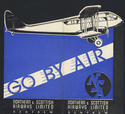 The first sustained passenger air service from Glasgow departed from Renfrew Airport on 27 April 1933. The Midland & Scottish Air Ferries flight to Campbeltown was in response to demand from passengers to travel on an experimental newspaper service that had begun on 18 April. The service was extended to Islay on 16 May, Midland & Scottish having inaugurated the Scottish Air Ambulance Service to the island two days earlier. By 1934 the company was flying passengers to Belfast, Isle of Man, Liverpool and London (Romford), but John Sword, its proprietor, had to close the airline down following an ultimatum from bus operators Scottish Motor Traction (SMT). Sword held a well-paid senior position with SMT which also had aviation interests and saw Sword's airline as representing a conflict of interest. He was forced to make a choice between the two and as Midland & Scottish showed no immediate signs of becoming profitable, Sword felt obliged to remain with SMT.
The first sustained passenger air service from Glasgow departed from Renfrew Airport on 27 April 1933. The Midland & Scottish Air Ferries flight to Campbeltown was in response to demand from passengers to travel on an experimental newspaper service that had begun on 18 April. The service was extended to Islay on 16 May, Midland & Scottish having inaugurated the Scottish Air Ambulance Service to the island two days earlier. By 1934 the company was flying passengers to Belfast, Isle of Man, Liverpool and London (Romford), but John Sword, its proprietor, had to close the airline down following an ultimatum from bus operators Scottish Motor Traction (SMT). Sword held a well-paid senior position with SMT which also had aviation interests and saw Sword's airline as representing a conflict of interest. He was forced to make a choice between the two and as Midland & Scottish showed no immediate signs of becoming profitable, Sword felt obliged to remain with SMT.
 George Nicholson's Northern & Scottish Airways arrived in 1935 and a network was built up serving such places as Barra, Belfast, Campbeltown, Inverness, Islay, North Uist, Perth, Skye, South Uist and Tiree. Following absorption by larger airline conglomerates Northern & Scottish became Scottish Airways in 1937. The railway companies established their own airline, Railway Air Services, in 1934, and it dominated air travel to England from 1935. Glasgow's first international arrival was a swastika-bearing Lufthansa Junkers Ju52 on 12 October 1936. It had flown from Cologne carrying the German national football team to face Scotland at Ibrox. (The score was Scotland 2, Germany 0.)
George Nicholson's Northern & Scottish Airways arrived in 1935 and a network was built up serving such places as Barra, Belfast, Campbeltown, Inverness, Islay, North Uist, Perth, Skye, South Uist and Tiree. Following absorption by larger airline conglomerates Northern & Scottish became Scottish Airways in 1937. The railway companies established their own airline, Railway Air Services, in 1934, and it dominated air travel to England from 1935. Glasgow's first international arrival was a swastika-bearing Lufthansa Junkers Ju52 on 12 October 1936. It had flown from Cologne carrying the German national football team to face Scotland at Ibrox. (The score was Scotland 2, Germany 0.)
 Air services from Glasgow to the Hebrides were sustained throughout World War Two, the aircraft camouflaged and passenger windows masked to prevent travellers observing military and shipping movements. Scottish Airways looked forward to further development following the war, but the passage of the 1946 Civil Aviation Act gave all domestic scheduled service rights to the newly created British European Airways Corporation (BEA). BEA assumed full responsibility for air services from Glasgow on 1 February 1947. BEA's services emulated the routes developed by Scottish Airways, Railway Air Services, and their predecessors, but it progressively introduced Douglas Dakota metal airliners to replace the fabric-covered biplanes that had formerly predominated. Glasgow Airport now had hard runways instead of a grass field and more sophisticated navigation systems to guide aircraft.
Air services from Glasgow to the Hebrides were sustained throughout World War Two, the aircraft camouflaged and passenger windows masked to prevent travellers observing military and shipping movements. Scottish Airways looked forward to further development following the war, but the passage of the 1946 Civil Aviation Act gave all domestic scheduled service rights to the newly created British European Airways Corporation (BEA). BEA assumed full responsibility for air services from Glasgow on 1 February 1947. BEA's services emulated the routes developed by Scottish Airways, Railway Air Services, and their predecessors, but it progressively introduced Douglas Dakota metal airliners to replace the fabric-covered biplanes that had formerly predominated. Glasgow Airport now had hard runways instead of a grass field and more sophisticated navigation systems to guide aircraft.